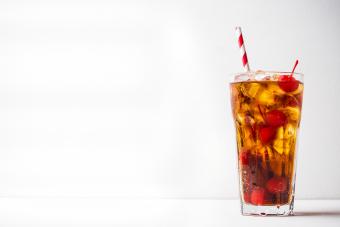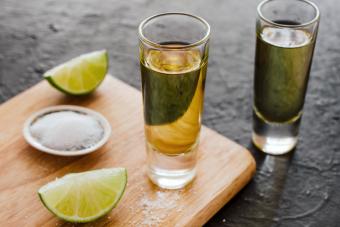
Armagnac is a small-batch brandy that hails from the Armagnac region of Gascony, France. It is similar to the more well-known French brandy, Cognac, but the Armagnac region produces smaller amounts and uses a slightly different distillation process and more types of grapes in their blends than Cognac. The result is a smooth, complex, flavorful spirit with a personality all its own you can enjoy alone or in cocktails.
How Armagnac Is Made
Armagnac is made from high acidity white wine with an alcohol by volume (ABV) of 7 to 12 percent. The wine is distilled using a single distillation process in a continuous column still called an alembic armagnaçaise. Distillation must be complete by March 31 of the year following the harvest of the grapes.
Aging the Armagnac
The resulting spirit (called eau-de-vie) is then aged in new French oak barrels called pièces for anywhere from about 6 months to around two years. The grain of the oak used in the barrels has a powerful effect on the flavors in the Armagnac. Wider grain provides more powerful flavors while a narrower grain provides subtler flavoring to the Armagnac. After the initial aging, the Armagnac is transferred to older oak barrels to prevent over flavoring from the wood and aged again. This adds toasty flavors, complexity, and richness.

Aeration During Aging
Many Armagnac producers aerate the spirit while it ages in oak by transferring it out of the oak into large vats and then pumping it back into the barrels. This mellows the flavors and allows them to develop.
Blending Armagnac
Eaux-de-vies from different grapes are aged into Armagnac separately until the cellarmaster feels sufficient aging has been achieved. Then, the various vintages of Armagnac are mixed in a process called coupage. Sometimes, distilled water is also added to the mixture to ensure the final product has an ABV of about 40 percent. Many Armagnacs are a blend of various vintages and grapes; vintage Armagnac contains grapes from a single harvest. During blending, a few different additives may be used, although only four are permissible. Those that are allowed are used to create balance and enhance the flavors or color of the brandy. Allowed additives include:
- Boisé - enhances aged characteristics of the brandy
- Water - to dilute to the proper ABV
- Sugar syrup - for sweetness
- Caramel - for color and consistency
Armagnac Grapes
Armagnac, like all other types of brandy, is distilled wine; however, the grapes used don't make very good wines, but they make wonderful Armagnac. It's the distilling and aging in oak that turn a blah wine into a very good brandy. The potent beverage is mainly made from the following four grapes, although producers can use up to ten white wine grapes.
- Folle Blanche
- Ugni Blanc
- Colombard
- Bacco
Additional grapes that can be used in Armagnac include:
-
Plant de Graisse
-
Meslier St François
-
Clairette de Gascogne
-
Jurançon Blanc
-
Mauzac Blanc
-
Mauzac Rosé
Armagnac's Age Designations
You can tell the age of an Armagnac by its designation on the label. The designation refers to the youngest vintage product in the bottle.
- VS (Very Special) - 1 to 3 years
- VSOP (Very Superior Old Pale) - 4 to 5 years
- Napoléon - Aged 6 to 9 years
- XO (Extra Old) - 6 years (pre-2018) and 10 years (after 2018)
- Hors d'âge - Over 10 years
- Vintage - These are aged a minimum of ten years and the date indicates a single harvest from the year the grapes are grown
Armagnac Regions
The Gascony region in France is further divided into three main Armagnac producing regions.
Bas-Armagnac
Armagnac produced in this region is made predominately of Ugni Blanc and Bacco grapes. This region is said to have the best soil, so it therefore produces the best Armagnac of the three regions.
Armagnac-Ténarèze
This region is centrally located and the main grapes used for Armagnac produced in Ténarèze are Ugni Blanc and Colombard.
Haut-Armagnac
This region produces the lower quality Armagnac as compared to the other two regions.
Characteristics of Armagnac
Armagnac's characteristics will depend on the age of the Armagnac, as well as how and where it is produced and the grapes used. In general, you can expect the following.
Color
Armagnac's color of an Armagnac is heavily dependant upon how long it was aged. The longer the spirit has spent in wood barrels, the richer the color. Younger Armagnac that hasn't spent much time in wood barrels is golden and honey colored while older Armagnacs are deep brown and mahogany in color. Aromas include vanilla, oak, nuts, and hints of dried dark fruits.
Aromas
The first scent of Armagnac will always be the alcohol. However, after the alcohol has tamed, subtler aromas will open up, such as vanilla, wood, roasted nuts and a hint of dried dark fruit.
Flavors
The flavors in the wine will depend on many factors, but particularly how long the wine spent aging in casks and the flavors of the different vintages of wines and grapes used to make the blend. You'll usually notice flavors such as prunes, orange peel, apricots, and spices along with deeper, richer notes of caramel or coffee.
How to Drink Armagnac
Armagnac is to be slowly sipped and enjoyed. Take only small sniffs and sips in order to experience its best flavors and aromas. Do not use a brandy snifter, which isn't ideal for experiencing the flavors and aromas of Armagnac. Instead, choose either a glass especially made for Armagnac or a tulip-shaped Champagne glass.

Sniff
Unlike sniffing wine's aromas, you don't want to stick your nose in a glass of Armagnac and take a big sniff or you could singe the inside of your nose with the alcohol. After the first initial sniff, wait a few minutes and bring it to the nose again. Now that your nose is used to the alcohol scent, you will be able to detect the gentler aromas of the Armagnac. You can also put a dab of Armagnac on the back of your hand and give it a moment. Then, sniff the dab to pick up the true scents of the Armagnac.
Sip
Take just a small sip. Let the Armagnac rest on your tongue and then swirl it gently around your mouth to get past the alcohol burn and enjoy all the subtle flavor of the spirit.
To Swirl or not to Swirl
Some people like to swirl; others prefer not to. Try both and see which works for you.
- Pro-swirlers believe Armagnac should be gently swirled before smelling and tasting in order to allow it to mix with the oxygen in the air which gently brings out some of the more delicate aroma and flavor characteristics.
- Anti-swirlers feel Armagnac should never be swirled before smelling or tasting because the act of swirling brings all the alcohol to the top. When this happens, the only thing you will smell and taste is the sharp nose and warm burn of the alcohol, not the flavors of the Armagnac.
Use It in Cocktails
You can also use Armagnac is classic cocktails such as the D'Artagnan or brandy and orange liqueur drinks.
Five Armagnac Brands to Try
You'll find two different types of branding of Armagnac. Producers are those who grow the grapes, age them, blend them, and bottle and sell them all in the same location, while negoçiants could own the vineyards or make the brandy, but they may not, as well.

1. Francis Darroze
Francis Darroze is an Armanac negoçiant from the Bas-Armagnac region. These Armangacs are well received by critics, earning ratings well above 90 points. Prices depend on age, vintage, rarity, and more, but can range anywhere from around $60 to about $2,500 or higher.
2. Delord
Delord is another Bas-Armagnac negoçiant. The House of Delord has been in the Armagnac business for three generations since the 1890s. The Delord 25-year is especially impressive, earning 96 points from Wine Enthusiast and 95 points from Distiller, and it only costs around $70 per bottle.
3. Domaine d'Espérance
Domaine d'Esperance is a producer in the Bas-Armagnac region. The XO Armagnac, which costs around $90 per bottle, is generally highly praised by critics. Wine Enthusiast gives it a hearty thumbs up with a 98 point rating.
4. Jollité
Jollité VSOP from Bas-Armagnac's Domaine de Joy may be the perfect starter Armagnac. At a price of just $40 per bottle, this Armagnac receives monster ratings from critics including a 97 point rating from Wine Enthusiast and a Silver Medal finish at the 2017 San Francisco Spirits Competition.
5. Castarède
Bas-Armagnac negoçiant Castarède offers a VSOP that costs between $50 and $60, but it's well-received by wine critics. Wine Enthusiast awards it 91 points, calling it mouth-watering.
Explore Armagnac
Next time you are reaching for that same old Single Malt Scotch or liqueur after dinner, consider a warm and inviting glass of Armagnac. You won't be sorry you did.







